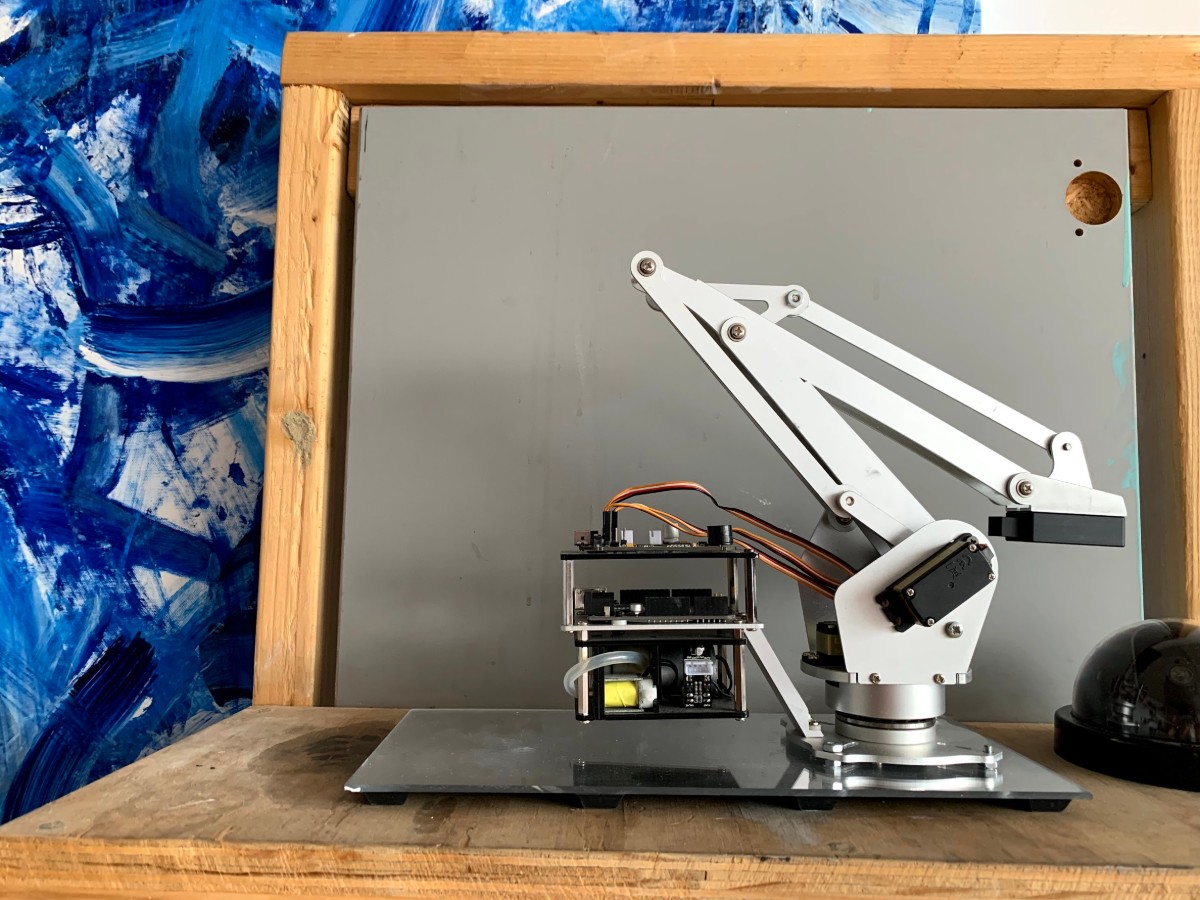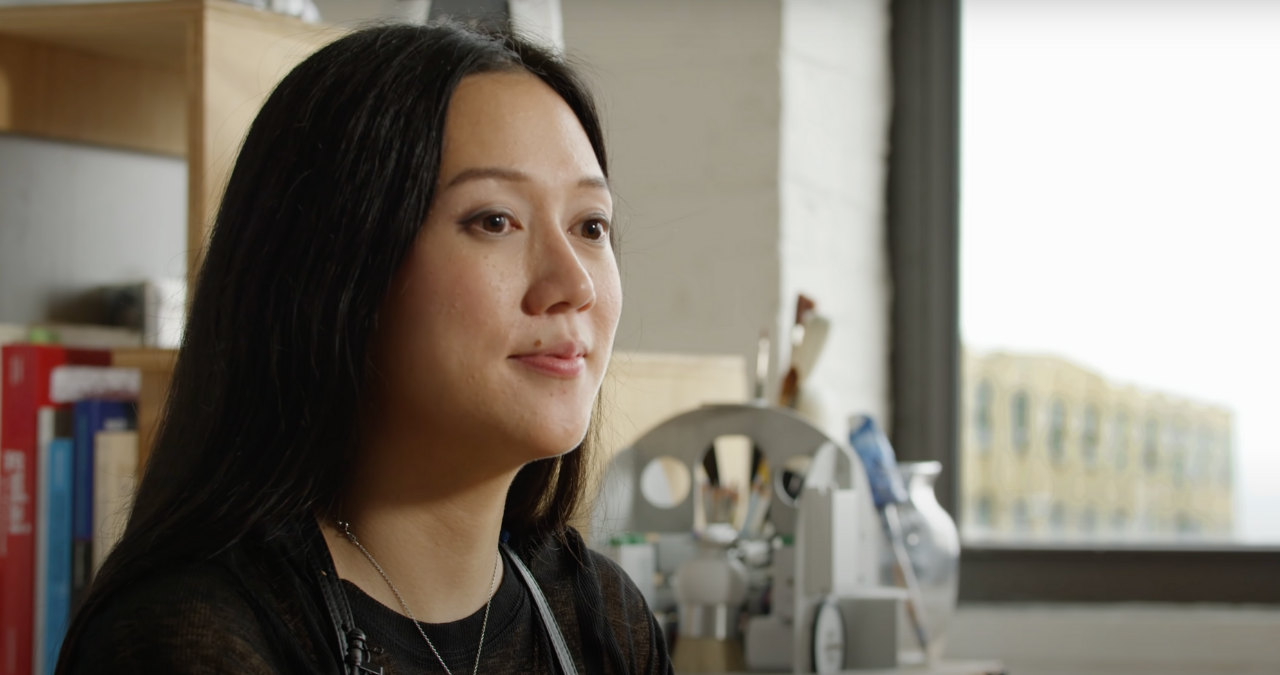Human-Robot Collaboration: 20 Questions with Artist-Researcher Sougwen Chung
As robots swirl around her, artist Sougwen Chung paints a picture of what the future of robotics could look like.
The daughter of a software engineer and an opera singer, Chung is naturally drawn to the relationship between art and science, human and machine. Through human-robot collaboration, she explores the practical possibilities of robotics and artificial intelligence (AI) in art, as well as the nature and impact of our relationships to these emerging technologies.
Caution: Humans and Robots at Work
Enterprises are onboarding more advanced robotic co-workers and AI assistants in the workplace. Around 82 percent of business leaders predicted humans and robots will work together on teams within five years, according to a 2018 survey from Dell and Vanson Bourne.
Tech-empowered artists like Chung work with robots and AI now. “I definitely think human and machine collaboration will become more common, because technology has become so engrained in our everyday lives,” she says.
Her art and research demonstrate how humans and robots can work together in harmony to achieve even greater feats (on creative tasks, no less). The results are beautiful.

Meet D.O.U.G.
D.O.U.G. (Drawing Operations Unit: Generation 1, 2 and 3) is Chung’s robotic co-creator and a work of art itself. “I’m starting to view them, a little bit, like kinetic sculptures,” she says.
How do the robots work?
- D.O.U.G._1: Robotic arms draw by mimicking Chung’s gestures in real time via an overhead camera and computer vision software. Together, D.O.U.G._1 and Chung improvise a synchronized art performance.
- D.O.U.G._2: Robotic arms improvise a duet with Chung via machine learning, based on her previous drawings. “The primary driver of the robots is a recurrent neural network that essentially generates a most likely behavior based on the model its trained on,” she says.
- D.O.U.G._3_L.A.S. (Live Autonomous System): Robotic swarm paints by responding to real-time data (e.g., biometric and city) during the performance.
Entering Unexplored Territory
Alone, machine learning and automation make work convenient and efficient. Together, machines and humans can do so much more.
So often we only consider AI and robots for their practical functions and how they can independently replace things we currently do rather than how we might be able to work collaboratively to create something bigger and better than either of us might have on our own.
Emma Boyle, This Artist Is Using a Robotic Arm to Show How Humans and AI Can Work Together, Gadgette
As Chung grew up, she didn’t think of technology as in opposition to or a replacement for her art, but as a tool to expand her creativity. In the chaos of D.O.U.G. and Chung’s real-time collaboration, the partners find a quiet, creative flow and co-create new, unforeseeable forms.
“The output of the drawing system is a reflection of the work that I’ve done to date, but also the work I’m creating in real time,” she says. “It’s unpredictable every time I do it.”
Chung also uses technologies like augmented and virtual reality to expand the shared canvas into an inhabitable, digital world. “Painting in virtual reality is not like painting in regular reality,” she says. “It turns into more of something like sculpture.”
Utopia or Dystopia? The Future of Robotics and AI
We tend to think about the future of robots and AI in one of two outcomes:
- A utopia, like “The Jetsons,” where machine automation and benevolent AI dramatically advance society and our quality of life.
- A dystopia, like “WALL-E,” where machine automation and all-powerful AI cripple humanity and destroy the world.
Will we reassign our mundane tasks to our robot servants? Or will we lose our jobs and human agency to robot overlords? Or what if the future of robotics and AI—whether bright or bleak—is less about us versus them and more about us and them?
Good versus bad, handmade versus machine-made, improvisational versus computational. We humans tend to think in oversimplified dichotomies. How binary of us. But, as we learn from technology, we need to consider all the right data for the best answer. And it’s complex.
The data we generate contributes to a multi-dimensional view of society and reveals the promises, possibilities and paranoias of what we’re actually inputting into the AI system. So, in that way, I think the AI is a self-portrait of us.
Sougwen Chung, Artist and Researcher
A future with robots could very well be bliss, as humans build collaboration, empathy and trust with the technology we create. Chung shows us how.
As for the dystopian outlook, Chung believes cynicism can create limitations. “It's easy to resort to cynicism when thinking about technology,” she says. “Sometimes it’s justified, and even necessary. But it's a dangerous endpoint. The challenge is to move beyond it. Cynicism on its own isn't useful for thinking about the future, because it really limits the imagination.”

Prepare for robot teammates: Experience more of Chung’s art and research on human-robot collaboration at Sougwen.com.
